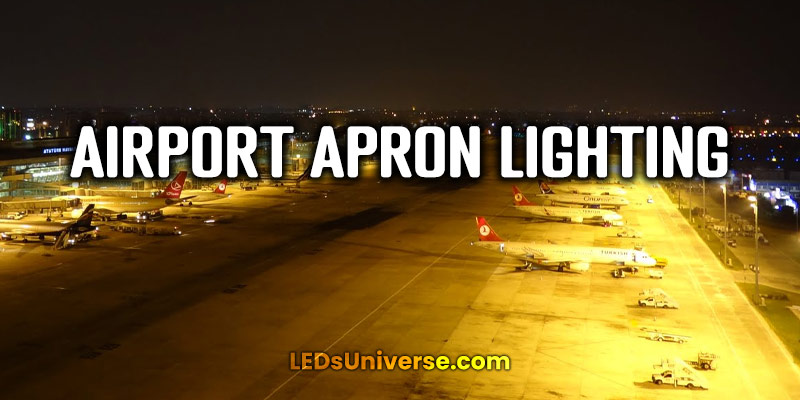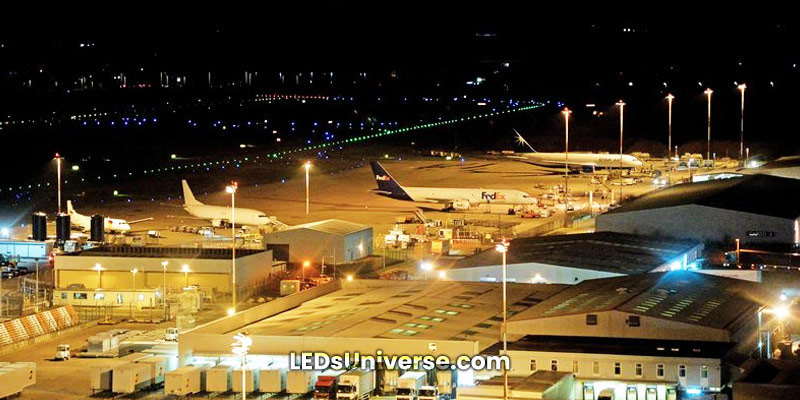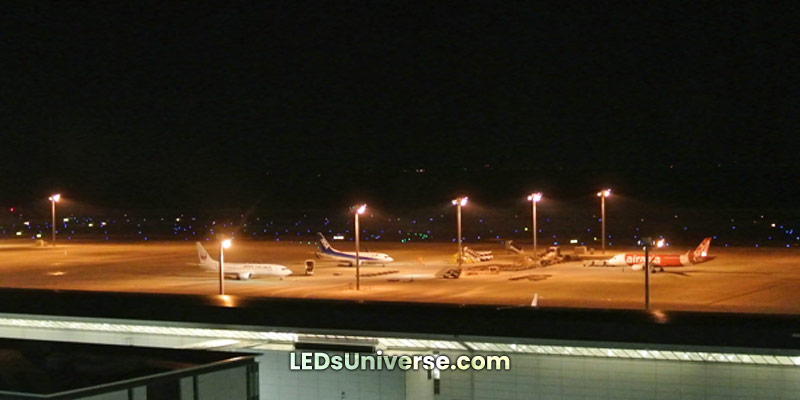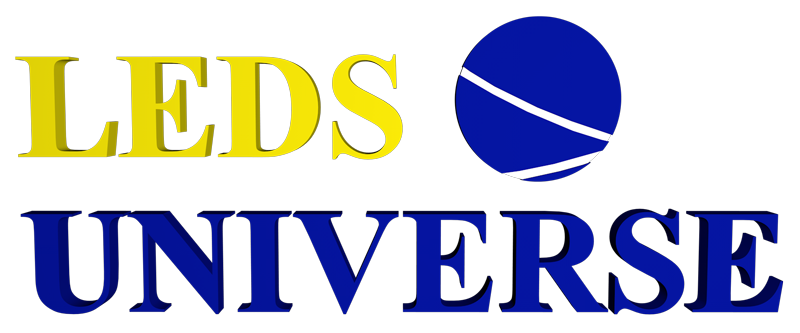
Airport apron lighting refers to the lighting systems and equipment that are used on the airport apron, which is the defined area on an airport where aircraft can be parked, loaded or unloaded, refueled, or boarded. The apron is typically located near the terminal building and is used for both passenger and cargo aircraft.
Importance of lighting on the apron
Safety
Proper lighting on the apron helps to ensure the safety of aircraft, ground vehicles, and personnel operating on the apron. It helps to clearly mark the boundaries of the apron, taxiways, and other areas, which helps to prevent collisions and other accidents.
Visibility
Apron lighting helps to improve visibility for aircraft and ground vehicles during times of low light or poor weather conditions. This helps to reduce the risk of accidents and incidents on the apron.

Guidance
Apron lighting helps to guide aircraft and ground vehicles to the correct positions on the apron, such as to a gate or a maintenance area. This helps to reduce confusion and improve efficiency.
Communication
Apron lighting can be used to communicate information to pilots and ground crew, such as the status of an aircraft or the availability of a gate.
Types of apron lighting
Taxiway edge lights
Taxiway edge lights are a type of airport apron lighting system that are used to mark the edges of the taxiways on an airport. Taxiways are the paved pathways on an airport that are used by aircraft to travel from one part of the airport to another, such as from the apron to the runway or from one gate to another.
Taxiway edge lights are typically installed along the edges of the taxiway and are used to define the edges of the taxiway and to provide guidance to pilots as they taxi their aircraft on the ground. These lights are usually installed in a continuous line along the edges of the taxiway and are positioned at regular intervals.
There are several types of taxiway edge lights, including centerline lights, touch down zone lights, and runway guard lights. Centerline lights are used to mark the center of the taxiway and are typically white in color. Touch down zone lights are used to mark the beginning of the runway and are typically yellow in color. Runway guard lights are used to mark the edges of the taxiway where it intersects with the runway and are typically red in color.
Hold position lights
Hold position lights are a type of airport apron lighting system that are used to mark the hold position on a taxiway or runway. The hold position is the designated area on the taxiway or runway where an aircraft is required to stop and wait before proceeding onto the active runway.
They are typically installed on either side of the hold position and are used to clearly mark the location where the aircraft is required to stop. These lights are typically red in color and are designed to be highly visible to pilots, even in poor visibility conditions.
Lead-on lights
Lead-on lights are a type of airport apron lighting system that are used to guide aircraft as they taxi onto a runway. Lead-on lights are typically installed on either side of the runway threshold and are used to mark the path that the aircraft should follow as it prepares to take off.
They are typically white in color and are installed at regular intervals along the sides of the runway. These lights are designed to be highly visible to pilots, even in poor visibility conditions.
Stop bar lights
Stop bar lights are a type of airport apron lighting system that are used to mark the location where an aircraft is required to stop before crossing an active runway. Stop bar lights are typically installed on the taxiway and are used to clearly mark the location where the aircraft is required to stop and wait for clearance to proceed onto the runway.
Other apron lighting systems
In addition to taxiway edge lights, hold position lights, lead-on lights, and stop bar lights, there are several other types of airport apron lighting systems that are used to improve safety and efficiency on the apron:
Apron floodlights
These lights are used to illuminate the apron during times of low light or poor visibility. They are typically mounted on poles or other structures and are used to improve visibility on the apron.
Runway threshold lights
These lights are used to mark the beginning of the runway and are typically white or yellow in color. They are installed at the runway threshold and are used to guide pilots as they take off or land.
Runway end lights
These lights are used to mark the end of the runway and are typically red in color. They are installed at the end of the runway and are used to indicate to pilots when they have reached the end of the runway.
Runway centerline lights
These lights are used to mark the centerline of the runway and are typically white in color. They are installed at regular intervals along the centerline of the runway and are used to guide pilots as they take off or land.
Runway guard lights
These lights are used to mark the edges of the runway and are typically red in color. They are installed at the edges of the runway and are used to indicate to pilots when they are approaching the edge of the runway.
Design and installation of apron lighting
Factors to consider when designing apron lighting systems
There are several factors to consider when designing an airport apron lighting system:
Operational needs
The design of the apron lighting system should take into account the specific operational needs of the airport, such as the type and size of aircraft that will be using the apron, the layout of the apron and surrounding areas, and the type and frequency of activities that will be conducted on the apron.
Visibility
The apron lighting system should be designed to provide adequate visibility for pilots, ground crew, and other personnel operating on the apron, especially during times of low light or poor visibility conditions. This may involve the use of high-intensity lights or other specialized lighting systems.
Energy efficiency
The apron lighting system should be designed to be energy efficient, as it will be in use for long periods of time and may consume a significant amount of electricity. Energy-efficient lighting systems can help to reduce operating costs and minimize the environmental impact of the airport.
Maintenance
The apron lighting system should be designed to be easy to maintain, as it will be subject to frequent use and may be exposed to harsh weather conditions. Consideration should be given to the ease of replacing bulbs and other components, as well as the overall durability and reliability of the lighting system.
Regulations and guidelines
The apron lighting system should be designed in accordance with relevant regulations and guidelines, such as those set forth by the International Civil Aviation Organization (ICAO) and the Federal Aviation Administration (FAA). These guidelines cover issues such as the minimum intensity of the lights, the color of the lights, and the placement of the lights on the apron.
Regulations and guidelines for installation of apron lighting

There are several regulations and guidelines that must be followed when installing an airport apron lighting system. These guidelines are designed to ensure the safety and efficiency of the apron and to ensure that the lighting system meets certain standards and requirements.
Some of the regulations and guidelines that may apply to the installation of an airport apron lighting system include:
International Civil Aviation Organization (ICAO) standards
The ICAO is a United Nations agency that sets standards and guidelines for the operation of international civil aviation. The ICAO has published several documents that provide guidance on the design, installation, and maintenance of airport apron lighting systems, including Annex 14 to the Convention on International Civil Aviation and the Manual of Standards Part 4 (Aerodromes).
Federal Aviation Administration (FAA) standards
The FAA is the national aviation authority of the United States and is responsible for the regulation of civil aviation in the country. The FAA has published several documents that provide guidance on the design, installation, and maintenance of airport apron lighting systems, including the Airport Design standards (FAA AC 150/5340-1L) and the Airport Lighting Equipment Certification Program (FAA AC 150/5345-43F).
Local regulations
In addition to international and national regulations, there may be local regulations that apply to the installation of an airport apron lighting system. These regulations may be set by the airport operator, the local aviation authority, or other relevant agencies and may cover issues such as the placement of the lights on the apron, the intensity of the lights, and the maintenance of the lighting system.
Maintenance and upkeep of apron lighting
Proper maintenance and upkeep of an airport apron lighting system is essential to ensure the safety and efficiency of the apron. Some of the key considerations for the maintenance and upkeep of apron lighting include:
Regular inspections
The apron lighting system should be inspected regularly to identify any issues or problems that may need to be addressed. This may involve checking the condition of the lights and other components, as well as testing the functionality of the lighting system.
Maintenance and repair
Any issues or problems identified during inspections should be addressed promptly through appropriate maintenance or repair. This may involve replacing bulbs or other components, cleaning and lubricating moving parts, or performing other types of maintenance as needed.
Preventative maintenance
Regular preventative maintenance can help to extend the life of the apron lighting system and reduce the need for costly repairs. This may involve performing routine tasks such as cleaning and lubricating the lights, replacing bulbs before they fail, and checking for other issues that may need to be addressed.
Record keeping
It is essential to keep accurate records of the maintenance and upkeep of the apron lighting system, including any inspections, repairs, or preventative maintenance that has been performed. These records can help to identify trends and potential issues that may need to be addressed in the future.
Proper maintenance and upkeep of an airport apron lighting system is essential to ensure the safety and efficiency of the apron. Regular inspections, maintenance, and repair, as well as preventative maintenance and accurate record keeping, can help to keep the lighting system in good working order and reduce the risk of accidents or incidents on the apron.
Future developments in apron lighting technology
There are several potential developments in apron lighting technology that could impact the safety and efficiency of airport operations in the future:
LED lighting
LED (light-emitting diode) technology has become increasingly popular in apron lighting systems due to its energy efficiency and long lifespan. LED lights use less electricity and generate less heat than traditional light sources, which can help to reduce operating costs and improve the overall efficiency of the apron lighting system.
Smart lighting
Smart lighting systems use advanced technology to adjust the intensity and color of the lights based on various factors, such as the time of day, the weather conditions, and the presence of aircraft or ground vehicles on the apron. Smart lighting systems can help to improve visibility and safety on the apron and may also be more energy efficient than traditional lighting systems.
Wireless communication
Advances in wireless communication technology could enable the integration of apron lighting systems with other airport systems, such as air traffic control systems or maintenance tracking systems. This could allow for more efficient and coordinated operation of the apron and may also improve safety by providing real-time information to pilots and ground crew.
Solar power
The use of solar power to power apron lighting systems could potentially reduce the energy consumption and operating costs of the apron. Solar-powered apron lighting systems may be particularly useful in remote locations or in areas with limited access to electricity.
There are many potential developments in apron lighting technology that could improve the safety and efficiency of airport operations in the future. These developments may involve the use of advanced lighting technologies, smart systems, wireless communication, and alternative energy sources, among other things.
Conclusion
Airport apron lighting is an essential aspect of airport operations, as it helps to ensure the safety, efficiency, and communication on the apron. There are various types of apron lighting systems, including taxiway edge lights, hold position lights, lead-on lights, stop bar lights, and other specialized lighting systems. These lighting systems are designed to meet specific operational needs and are installed according to specific regulations and guidelines.
If you are interested in improving the safety and efficiency of your airport apron, we invite you to contact us to get a free lighting design. Our team of experts has years of experience in designing and installing airport apron lighting systems and can help you develop a customized solution that meets the specific needs of your airport. We offer a range of lighting systems and technologies, including LED lighting, smart lighting systems, and solar-powered lighting, and we can help you choose the best options for your airport. Contact us today to get started on your free lighting design and take the first step towards a safer and more efficient airport apron.
